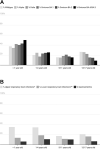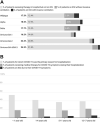Epidemiology of 7375 children and adolescents hospitalized with COVID-19 in Germany, reported via a prospective, nationwide surveillance study in 2020-2022
- PMID: 38168119
- PMCID: PMC10762173
- DOI: 10.1038/s41598-023-49210-1
Epidemiology of 7375 children and adolescents hospitalized with COVID-19 in Germany, reported via a prospective, nationwide surveillance study in 2020-2022
Abstract
By means of a nationwide, prospective, multicenter, observational cohort registry collecting data on 7375 patients with laboratory-confirmed SARS-CoV-2 admitted to children's hospitals in Germany, March 2020-November 2022, our study assessed the clinical features of children and adolescents hospitalized due to SARS-CoV-2, evaluated which of these patients might be at highest risk for severe COVID-19, and identified underlying risk factors. Outcomes tracked included: symptomatic infection, case fatality, sequelae at discharge and severe disease. Among reported cases, median age was one year, with 42% being infants. Half were admitted for reasons other than SARS-CoV-2. In 27%, preexisting comorbidities were present, most frequently obesity, neurological/neuromuscular disorders, premature birth, and respiratory, cardiovascular or gastrointestinal diseases. 3.0% of cases were admitted to ICU, but ICU admission rates varied as different SARS-CoV-2 variants gained prevalence. Main risk factors linked to ICU admission due to COVID-19 were: patient age (> 12 and 1-4 years old), obesity, neurological/neuromuscular diseases, Trisomy 21 or other genetic syndromes, and coinfections at time of hospitalization. With Omicron, the group at highest risk shifted to 1-4-year-olds. For both health care providers and the general public, understanding risk factors for severe disease is critical to informing decisions about risk-reduction measures, including vaccination and masking guidelines.
© 2023. The Author(s).
Conflict of interest statement
The authors declare no competing interests.
Figures




References
-
- DGPI: Deutsche Gesellschaft für Pädiatrische Infektiologie. Ergebnisse des COVID-19-Surveys (01.01.2020–30.11.2022). https://dgpi.de/covid-19-survey-update/ (2023).
Publication types
MeSH terms
Supplementary concepts
LinkOut - more resources
Full Text Sources
Medical
Miscellaneous

